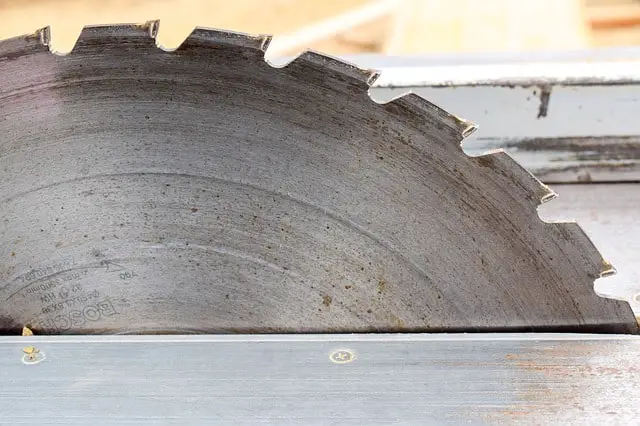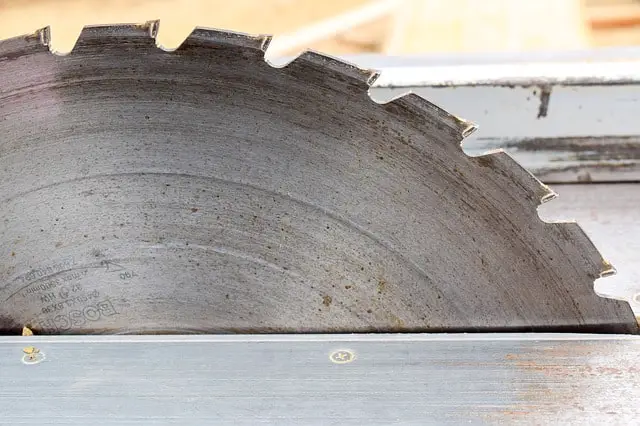Can a bandsaw replace a table saw? If you’re someone who loves working with wood, you might have pondered this question. Well, my friend, today we’re going to dive into the world of power tools and explore the capabilities of these two mighty machines. So buckle up, grab your safety goggles, and let’s get sawing!
Now, I know you’re probably wondering what makes a bandsaw so special and if it can truly replace a table saw. The truth is, both tools have their own unique strengths and purposes. A bandsaw is fantastic for intricate cuts and curves, allowing you to create beautiful scrollwork and cut out intricate shapes with ease. It’s like a precision surgeon on your workshop table!
On the other hand, a table saw is a brute force of nature. It’s the go-to tool for ripping long boards and making straight, clean cuts. Need to build a bookshelf or a sturdy workbench? The table saw has got your back! But can the bandsaw stand up to the table saw’s raw power and versatility? Let’s find out, my young woodworking apprentice!

Can a Bandsaw Replace a Table Saw?
In the world of woodworking, both the bandsaw and the table saw are essential tools that offer unique capabilities. However, many woodworkers wonder if a bandsaw can serve as a suitable replacement for a table saw. In this article, we will explore the advantages and limitations of bandsaws and table saws, and discuss whether a bandsaw can indeed replace a table saw in certain woodworking tasks. We will delve into the features and functions of both tools, explore their differences, and provide guidance on when and how to use each one effectively. So, let’s dive in and find out if a bandsaw can truly fill the shoes of a table saw in the woodworking realm.
Benefits of Using a Bandsaw
A bandsaw is a versatile power tool that can handle a wide range of cutting tasks. It features a continuous looped blade stretched between two wheels, allowing it to make precision cuts through various materials, including wood, metal, and plastic. The key benefits of using a bandsaw include:
- Versatility: A bandsaw can be used for both straight and curved cuts, making it ideal for intricate and detailed workpieces.
- Resawing Capability: Resawing refers to cutting a thick piece of wood into thinner slices. Bandsaws excel at resawing, as they produce consistent, smooth cuts without excessive waste.
- Safe Operation: Bandsaws are generally considered safer than table saws because the blade is fully enclosed, reducing the risk of accidents.
Can a Bandsaw Replace a Table Saw?
While bandsaws offer significant advantages, they have distinct limitations that prevent them from fully replacing a table saw in every scenario. Here are a few key points to consider:
- Cutting Capacity: Bandsaws typically have a smaller cutting capacity compared to table saws. Table saws can handle larger workpieces and make precise rip cuts with ease.
- Fence Stability: Table saws generally have more stable and accurate fences, which are crucial for making precise and repeatable cuts. Bandsaws may struggle to replicate this level of accuracy.
- Availability of Accessories: Table saws have a wide range of accessories and attachments available, such as dado blades and miter gauges, which enhance their versatility. Bandsaws have fewer options in terms of accessories.
While a bandsaw can handle many tasks traditionally performed on a table saw, there are certain scenarios where the precision and capacity of a table saw are indispensable. It ultimately depends on the specific woodworking projects and preferences of the user.
When to Use a Bandsaw and When to Use a Table Saw
Knowing when to use a bandsaw and when to use a table saw is key to optimizing the efficiency and quality of your woodworking projects. Here are some guidelines:
When to Use a Bandsaw
1. Curved Cuts: Bandsaws shine when it comes to cutting complex curves and intricate shapes. Their ability to make precise, intricate cuts makes them the go-to tool for tasks like cutting chair legs or scrollwork.
2. Resawing: Bandsaws are unbeatable when it comes to resawing. If you need to slice thick pieces of wood into thinner boards, a bandsaw is the ideal choice.
3. Thick Lumber: Bandsaws easily handle thick lumber that may exceed the cutting capacity of a table saw.
When to Use a Table Saw
1. Straight Cuts: Table saws excel at making accurate, straight cuts, especially for ripping boards or cross-cutting larger panels.
2. Precision and Repeatability: Table saws offer more stability and accurate fences, making them the preferred choice for projects that require precision and repeatability.
3. Large Workpieces: Table saws have a larger cutting capacity, allowing for easy handling of larger workpieces.
Choosing the Right Tool for Your Woodworking Projects
Both bandsaws and table saws are invaluable tools in the world of woodworking, but they each have their strengths and limitations. Instead of thinking of them as replacements for each other, it is best to view them as complementary tools that serve different purposes. By understanding the unique capabilities of each tool, you can make informed decisions and choose the right one for each specific project. Remember to prioritize safety, efficiency, and precision in your woodworking endeavors, and let your bandsaw and table saw work together to enhance your craftsmanship.
Key Takeaways: Can a Bandsaw Replace a Table Saw?
- A bandsaw and a table saw are both powerful woodworking tools.
- While they have some overlapping functions, they are designed for different purposes.
- A bandsaw is great for precision cutting curves and irregular shapes in wood.
- A table saw is ideal for making straight, precise cuts with larger pieces of wood.
- While a bandsaw can perform some tasks of a table saw, it can’t fully replace it.
Frequently Asked Questions
When it comes to woodworking tools, bandsaws and table saws are both popular choices. While each tool has its own strengths and purposes, can a bandsaw replace a table saw completely? Let’s find out with these frequently asked questions!
1. Can a bandsaw do everything a table saw can?
While a bandsaw is a versatile tool, it can’t exactly replace a table saw completely. Table saws are known for their precision and ability to make straight cuts through various materials, thanks to their flat tables and powerful motors. However, bandsaws do excel in cutting curves and irregular shapes like no other tool can. So, while a bandsaw can handle some tasks that a table saw can, it doesn’t match up in terms of straight cuts and dimensional accuracy.
Additionally, a bandsaw doesn’t come with a rip fence or miter gauge like a table saw does, making it more challenging to achieve consistent, repeatable cuts. So, while a bandsaw is a valuable addition to a workshop, it’s best used in conjunction with a table saw rather than as a complete replacement.
2. What are the advantages of using a bandsaw over a table saw?
A bandsaw offers several advantages over a table saw that make it a valuable tool in any woodworker’s arsenal. First and foremost, a bandsaw can make intricate curved cuts with ease. Its blade moves in a continuous loop, allowing for greater maneuverability and the ability to cut shapes that would be challenging on a table saw. If you’re working on projects that require curved cuts, a bandsaw is the way to go.
Another advantage is the bandsaw’s ability to resaw lumber. Resawing is the process of cutting a board into thinner pieces, and bandsaws are perfect for this task. With the right blade, a bandsaw can slice through thick boards like butter, giving you the ability to create bookmatched panels or veneers. This is a capability that a table saw doesn’t possess. So, if you’re into resawing or need to make complex curved cuts, a bandsaw is the tool for you.
3. Are there any types of cuts that are better suited for a table saw?
Yes, indeed! Table saws excel at making straight cuts and crosscuts. With the help of a rip fence, a table saw ensures precise and accurate cuts along the length of a board. Whether you’re cutting plywood, solid wood, or even sheet metal, a table saw provides the stability and guidance needed for straight, clean cuts.
Table saws are also well-suited for making repetitive cuts. With the help of a miter gauge, you can make uniformly angled cuts or precise and repeatable crosscuts for projects that require multiple identical pieces. So, if you’re working on a project that demands straight cuts or repetitive cutting tasks, a table saw is the go-to tool.
4. Can a bandsaw be used to rip boards like a table saw?
While a bandsaw can perform rip cuts, it’s not the most ideal tool for the job. Bandsaws are primarily designed for cutting curves and irregular shapes, and ripping boards requires a different setup. Unlike a table saw that comes with a rip fence to guide the workpiece, a bandsaw lacks this feature. This makes it more challenging to achieve consistent, parallel rip cuts.
However, with the right setup, a bandsaw can still be used for ripping narrower boards or making rough cuts before finalizing dimensions. It may require additional techniques like using a sled or a well-aligned fence. If ripping boards is a frequent task in your woodworking projects, a table saw would be a more appropriate choice.
5. Can you use a bandsaw and table saw together for more versatility?
Absolutely! Combining a bandsaw and a table saw in your woodworking shop can offer you the best of both worlds. With a table saw for straight, accurate cuts and a bandsaw for curved cuts and resawing, you’ll have a comprehensive set of tools that cover a wide range of woodworking tasks.
By having both tools at your disposal, you can maximize your creativity and efficiency in the workshop. Whether you’re working on furniture, cabinetry, or smaller projects, the bandsaw and table saw tandem allows you to tackle various cutting needs with ease.

Summary
If you’re wondering whether a bandsaw can replace a table saw, the answer is no. Both tools have different functions and are designed for specific tasks. A bandsaw is great for cutting curves and irregular shapes, while a table saw is better for making straight cuts and ripping boards.
A bandsaw may be able to do some of the things a table saw can do, but it lacks the stability and precision that a table saw provides. So, if you’re looking for versatility and accuracy, having both tools in your workshop would be ideal. Remember, each tool has its strengths and weaknesses, so choose the one that suits your needs best and always prioritize safety when working with power tools.
